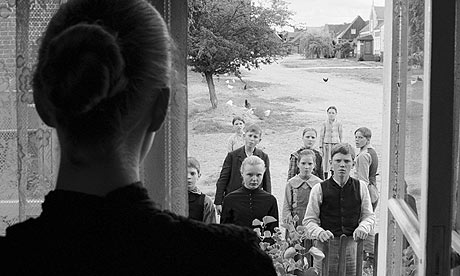White ribbons; repression and its consequences
Eichvald is a small Baronial village in northern Prussia, a patriarchal society dominated by powerful male autocrats who justified their abuse of their womenfolk and their children on the grounds that it was what they needed. ‘This will hurt me more than it hurts you’.
It is the autumn of 1913 and strange things have begun to happen in the village. First it is the doctor’s ‘accident’. His horse trips on a wire stretched across the gate to his house, throwing him heavily, the end of his collarbone sticking out through the skin of his shoulder. Next the farmer’s wife falls through the rotten floor of the baron’s sawmill and is killed instantly. In revenge and anger with his father, who refuses to claim compensation or grievance, their eldest son destroys the baron’s field of cabbages and is instantly dismissed, committing the family to starvation. Then Sigi, the Baron’s son is kidnapped, flayed and found in the middle of the night hanging by his ankles in the barn in a state of severe shock. Then the steward’s baby son is left exposed to the freezing cold. Finally Karli, the midwife’s son, who has Down’s syndrome is attacked and nearly blinded. The culprits are never discovered though a sinister group of children always seem to materialise offering to help after each an atrocity is committed. It might appear that, led by Klara, the pastors eldest daughter, they are taking their revenge for the cruel repression they had endured at the hands of their fathers, but we never quite know for sure.
When Klara and Martin arrive late for supper, the pastor forces them to wear white ribbons as a sign that they have not learnt to be responsible. Martin is further humiliated by having his hands tied to the sides of his bed to stop him masturbating while Klara collapses while being severely and unjustly reprimanded by her father in front of the whole class.
And then there is the doctor, who, not just content for abusing his housekeeper, is also forcing his attentions on Anni, his fourteen year old daughter. And the steward, who thrashes his son within an inch of his life for taking Sigi’s whistle from him and throwing him in the pond. This is a highly dysfunctional village that seems to thrive on malice.
And Eva, who is unfairly dismissed by the Baron and then prevented by her father from marrying her sweetheart, who teaches at the village school.
It is the schoolteacher who finds out what has happened, but when he confronts Klara and Martin, they lie; they know only too well the penalties for being honest. Their father, the parson, grows angry and accuses him of spreading calumny on innocent children and threatens to report him to the school board.
The note attached to Karli notes that the sins of the fathers are visited on their children. It would seem that Klara and her gang become avenging angels. Klara even kills her father’s pet bird, though her youngest brother poignantly offers to replace it with the bbird he has rescued because his father is so sad.
The film ends with the news of the assassination of Archduke Ferdinand in Sarajevo and the imminence of war. We are left with the sense that in some way the children have brought about the horror that was the first world war. They didn’t, but the narrator, who is the schoolteacher as an old man, says that the events in Eichvald in 1913/14 might clarify what was eventually going to happen in Germany. Theirs was the generation who became Nazis and perpetrated their own cruel repression on the Jews.
White Ribbon was directed by Martin Hanneke and released in 2009, being awarded ’ La Palme d’Or’ in Nice. It is a powerful and disturbing film. It is the children are the stars of the film; they act their parts with such convincing realism while the cimetography with its long gothic shots of the snowbound village and its protestant inhabitants reinforces the dark repression.



